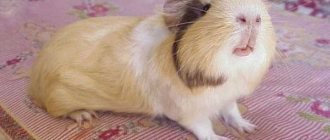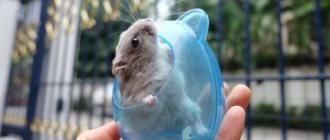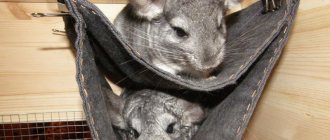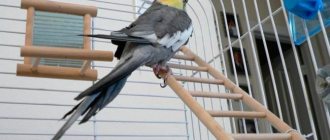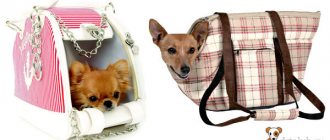Choosing a cell
At first glance, guinea pigs seem to be passive and calm animals. But this is not true at all. A healthy animal, if released from its cage, will delight its owner with good speed, agility and resourcefulness. This means that the animal requires a fairly large area to feel comfortable. One individual can live in a cage whose dimensions are at least 100 x 70 cm. If you are planning to have a pair, you should choose a house for a guinea pig with dimensions of 140 x 70. The only thing these animals are not too demanding on is the number of tiers. The animals feel quite comfortable in a one-story cage. If you are going to purchase a cage or make one yourself, remember that you will need to equip it with a shelter, an area for eating, and also place other accessories.
WE EQUIP A HOUSE FOR A GUINEA PIG
Contents hide
Now you and I are armed with the minimum necessary knowledge regarding choosing a guinea pig. Once again we want to congratulate you on your good choice - a guinea pig will be a wonderful pet, perfect for families with children. However, it is too early to go to a pet store to choose an animal. In today's article, Lianne McLeod will tell us in what conditions guinea pigs prefer to live and how best to arrange a house for them.
Guinea pigs are social animals and live very well in pairs, so initially it would be a good idea to get two friends at once. If you do this at an older age, there is a risk that the pigs will not “get along” with each other, they are such “picky” animals. Guinea pigs also do not like cramped living conditions, so the future cage should be quite spacious (we repeat, it is better to choose a cage for a couple of animals at once). Old guidelines recommended purchasing cages at a rate of 2 square feet per animal. This is clearly not enough. Cavycages.com experts in their latest recommendations advise maintaining standards of 7.5 square feet (0.8 square meters) for one animal and 10.5 square feet (1.2 square meters) for a pair. If the cage is a little larger, purchase it anyway, since having additional space will only benefit the animals. Ideally, it would be great to make a cage yourself, but when buying a ready-made house, follow the principle “the more spacious, the better.”
More about the cage. Don't choose products with wire floors or hanging ramps - guinea pigs won't need them. Cages with ramps, low plastic shelves, and ledges can work, but they should still be chosen with caution—these additions will only take away space from the overall space and prevent your pets from being able to roam freely around their cage.
The distance between the bars of the cage should not exceed one inch (2.5 cm) for adult guinea pigs. It’s good that guinea pigs are quite large animals; they do not have the need to constantly climb and climb somewhere. They chew more than they climb. Therefore, the sides of the cage can be made not so high (18 inches, or 45 cm upper limit). If you have a large enough apartment, you can give room for imagination and free rein to your skillful hands. On the Internet you will find many examples of “creative” arrangement of cells. Cells like “Cubes and Coroplast” are widespread, take a closer look.
About the litter. A wooden filler is almost ideal (it is better to choose pine or cedar; the option with aspen is also suitable). As a last resort, you can lay down hay or choose the most economical option - paper filler. It is quite cheap and absolutely harmless to your pets.
Boxing "nest". Remember that guinea pigs just love to hide from the hustle and bustle of the outside world from time to time, so you definitely need to equip such a place in the cage. This is quite simple. You can use an old plastic bucket or trough by making a hole and turning it over. Simple cardboard boxes will do - they need to be changed more often. Finally, an excellent option is a piece of PVC pipe with a large cross-section - pigs will happily hide there.
Toys. They can be placed in the cage to provide variety for your pet's leisure time. Good choices are paper bags and cardboard boxes (also for playing hide and seek, see above), crumpled paper, balls, plastic toys in the shape of a cat or rabbit. You can arrange additional tunnels and put a small fleece blanket. Hanging toys that are bought for birds are also interesting for guinea pigs. The main rule is that toys should not have small parts that can come off or be easily chewed off, thereby damaging the respiratory tract.
A set of food and water. A ceramic product is the best choice for a bowl. To ensure that your pet always has fresh water, it is better to buy a special sippy cup: a regular saucer of water will not work. Please note that guinea pigs drink quite a lot, so make sure that the water supply is replenished on time. Guinea pigs constantly need to chew: firstly, they are rodents, and secondly, if their teeth are not constantly loaded with work and thus not ground down, the front incisors quickly grow to fantastic sizes. Therefore, the cage should always have a supply of fresh hay and a mineral stone. All this is on sale. Your guinea pig cage should be cleaned approximately once a week by cleaning it with hot, soapy water. Read more about the diet of guinea pigs in the article “Do you have a guinea pig? Feed her correctly” on our portal.
Entertainment. Do you have a large apartment and plenty of time for entertainment? Wonderful! Large chain stores will offer small pens and various additional accessories where you can place your pets from time to time for exercise outside the cage. Also make sure that there are no wires nearby - pigs can easily chew them. Don’t be surprised, but guinea pigs love to travel; special travel cages are available for sale. Animals can be let out for a walk in the open air, on fresh grass. Just make sure first that your lawns have not been treated with any pesticides. Now go shopping!
Original publication: Cages for Guinea Pigs. Author: Lianne McLeod. Source and photo:
How to make a cage with your own hands?
Today, in pet supply stores you can purchase any accessories for keeping and caring for animals. Remember that you can also make a guinea pig house with your own hands. This option is good because you can choose the size and configuration of the home yourself. In addition, a ready-made home will cost you less than a factory-made option. So, how to make a house for a guinea pig? You will need tools and materials: metal mesh, connecting corners, thick corrugated cardboard (you can take a box from household appliances) or plywood, self-adhesive film.
Let's start by making the pallet. The paws of rodents are very sensitive, and therefore the animal should not be allowed to constantly run on the mesh; the floor should be level. Before settling the animal, sprinkle sawdust or special wood filler on it. Build a box with low sides from cardboard or plywood. This is done very simply - cut out a rectangle with allowances for the side walls, then cut out and assemble the structure. Cover the tray with film to protect it from moisture. Now you can assemble the cage itself from a metal mesh. Connect the four walls using metal corners and be sure to handle all sharp edges. Add a roof if desired, but experienced breeders say that only high side rails are sufficient for guinea pigs. If your cage is closed at the top, be sure to build a door on the side or at the top through which you will let the animal out for a walk and feed it.
Do you need a cage house?
In principle, there is no great need to equip a house for a cave, but the animal is still better off with it. This is an active rodent that needs rest after playing with its owner. This is not a cat whose favorite place to relax may be a chair or sofa: it doesn’t hurt for a pig to have personal space.
Did you know? Pigs were the first to be domesticated by the Indians of the South American Andes about 7 thousand years ago. They bred them exclusively for culinary purposes.
In addition, the animal is quite shy, and the house can become a refuge for it in case of danger. A house is needed both for nursing offspring and when the pet is not feeling well. If you keep several pets, you should build separate housing for each of them.
Making a shelter house
All rodents love to hide in secluded places; this is inherent in them at the genetic level. For large animals, it makes sense to make a house that fits inside the cage. The easiest option is to choose a plastic box of a suitable size (you can also use a food canister) and cut out an entrance in it. Such a shelter should not have a bottom. However, many breeders are worried that the animal will start chewing plastic. And this is really not very useful for the animal. We offer you simple advice on how to make a house for a guinea pig with your own hands from plywood or wood. The structure is a box consisting of four walls and a roof. The most difficult thing is to choose the optimal connection option. Remember that the animal will chew its shelter, which means that glue is not suitable for us. Choose short and thin carnations. When driving them in, make sure that the sharp ends do not stick out anywhere, and the animal will not be able to break the shelter and run into the nails.
What can you make a house from?
Today you can make a house from almost any material at hand. Most often it becomes wood, since houses made from it are not only environmentally friendly, but also durable. To make a cage, it is better to choose plywood or boards; they are easy to process and knock together.
In addition, a big plus of wood products is that this natural material allows your pet to calmly sharpen its teeth without harming the body.
Read more about how to choose housing for your guinea pig.
But this material also has a sufficient number of disadvantages:
- if you choose untreated material, pests may grow in it;
- the house will be quite weighty;
- the choice of colors is limited;
- if you do not remove the burrs, the rodent may be injured;
- It is quite difficult to clean the material, which contributes not only to the accumulation of bacteria, but also to the appearance of an unpleasant odor.
Cardboard is often the choice of choice for manufacturing - cardboard boxes are very easy to get, they are easy to use and require much less time to make and shape. In addition, such a house can be quickly replaced, and it remains as environmentally friendly as wood.
Important! When making a house for a pet, it is very important to calculate the area so as to adhere to the minimum values necessary for the pet’s comfortable existence. This will allow the pig to feel as free and calm as possible. For one pig you need an area of 0.7 square meters (or 70 by 100 centimeters), for two 1 square meter (140 by 70), for three 1.2 meters (170 by 70 centimeters) and for four
-
from 1.5 (or 210 centimeters by 70 centimeters).
The house will be light and comfortable, you can even take it with you. But the material is not durable and wears out quickly, which is the main problem. Very often, plastic is chosen to make a home for a guinea pig - it is much more durable than wood and very light.
You can choose almost any color, composition, size and thickness of the material. To make a house, you can even use large plastic hard containers or a children's construction set.
Such housing is not only much cheaper, but also more practical than any material. In addition, plastic is easier to clean than all other materials. But it has one major drawback - the material is poisonous, and if the animal starts gnawing on a plastic house, it can cause irreparable harm to the digestive system.
Sometimes glass aquariums or other glass forms are chosen as the house itself or its components. They are easy to care for, since washing and disinfecting them is quite simple, but the houses turn out to be heavy and dangerous. If a rodent begins to sharpen glass, it can injure the stomach and trachea, which will lead to death.
In addition, building a glass house is quite difficult, since the material is not easy to process at home. Houses are often made from fabric - they are the most practical and simple to build. They are easy to wash and handle and can be transported with you. The downside is that they get dirty quickly and will not be resistant to the teeth of the animal.
List of items prohibited in a guinea pig's home
If you are making a house for a guinea pig, use only new and clean materials, or, in extreme cases, food packaging. Remember that various paints and adhesives can be dangerous for the animal. It is unacceptable to keep guinea pigs in aquariums and plastic containers; in such conditions it is difficult to ensure good ventilation and acceptable humidity. A guinea pig cage should only be equipped with accessories designed specifically for these animals. Never buy running wheels, as the animal's legs are fragile, and do not give water in open bowls.
Advantages of arranging a homemade cage
Guinea pigs need a spacious and comfortable home.
They should not be kept in a hamster cage or aquarium. In the first case, it is too crowded and the animals will not be protected from drafts and temperature changes. In the second, pets will suffer from high levels of humidity. A homemade cage has a number of advantages:
- You can make a high-quality and spacious home for a rodent, spending less money than it would have been done if you bought a ready-made cage in a store.
- Freedom in choosing materials. A cage for rodents should be made from environmentally friendly and high-quality raw materials. The pet owner independently chooses the most suitable option.
- At the design stage of the structure, you can think through the necessary nuances to make cleaning the cage as convenient as possible.
- Options for expanding or reconstructing the territory of guinea pigs are selected in advance in case their number increases.
- In a spacious dwelling you can place all the items necessary for rodents: houses, hay barns, feeders, toys, etc. In addition, part of the contents of the cage can also be made independently from the remaining materials.
- The cage is designed based on the size of the place where it needs to be installed.
Some breeders believe that the advice to make a cage no longer has any scientific basis. However, the large area of the cage will allow the animal to move actively and not get bored even when the breeder does not have enough time to let the animal walk around the apartment. In the cage-aviary, the pig can play, run, explore the territory and even just go eat - it will take her time.
Movement is a good prevention of diseases of the lungs, heart, kidneys, and stomach. A large cage will also allow each pig to have its own corner and its own zone of comfort and relaxation. This means fights between animals will stop. The area of the pig's house also plays an important role when the female is expecting offspring or already has offspring.
A larger cage is easier to keep clean. It is much more convenient to clean, change food and bedding. Watching animals frolicking in an enclosure is also much more convenient and interesting.
The advantages of homemade cages for guinea pigs are obvious:
- It is absolutely easy to make, just like a cage for a budgie. You will not need to have specific knowledge and skills. All you need is a set of certain tools and materials, as well as the corresponding desire;
- This is an obvious money saver. Even if you buy some missing materials, it will still cost you many times cheaper than buying a ready-made cage in a store;
- unique opportunities open up for you in terms of creating unusual shapes and design solutions. The cage does not have to be a standard rectangular one. They can be made multi-level, non-standard shapes, tall or squat - the choice is always up to the owner, since there are no artificial frames typical for pet stores;
- This cage is easy to care for. Having initially thought through the design, you can make it so that it is easy to clean, change certain elements, etc.;
- it is good for the health of guinea pigs. If they are comfortable, they will be in the appropriate mood. Large sizes contribute to good physical fitness. All this will help ensure that your pet lives as long as possible;
- It should also be noted that you can keep your hands and head busy with a pleasant activity. Making something is always useful and exciting.
Making a home for a guinea pig is not difficult.
Do-it-yourself guinea pig hammock: step by step
The work will depend on the type of structure chosen. The easiest way to sew is rectangular and corner. But for a hammock in the form of a house you will have to try a little.
Rectangular
To create a rectangular model you need:
- Cut 2 identical pieces of fabric. The length will be about 50 cm, and the width will be about 30 cm. We also cut out another piece from the material for the layer (fleece). The length is 15-20 cm shorter.
- The edges of identical pieces are sewn together so that the wrong side is on the outside. One of the edges must be left unstitched.
- Now turn the finished product onto the face. Place the previously cut fleece inside.
- You need to sew up the last edge.
- We make holes in the corner sides and thread the ropes.
- We attach the product to the rods.
Angular
Creating a corner model is also easy:
- We measure the angle of the cell. Cut out 2 identical pieces of triangular shape from the selected fabric. This piece will have 2 short sides (called legs in mathematics), and 1 short side (hypotenuse). The size of the hypotenuse is about 60 cm, and each leg is about 40 cm.
- Cut out a piece of the interlayer (fleece). The shape is also triangular. But the dimensions of the sides are 10-15 cm smaller.
- Place the cut piece of fleece between two pieces of fabric.
- Sew all edges.
- We thread ropes through the corner parts of the hammock. But in this case, carabiners are better suited.
- We install a hammock in the corner.
Attention! Making a hammock lounger is more difficult because it requires more material and time.
Preparation of materials
To build a cage for a guinea pig yourself, you will need a minimum set of construction tools, which everyone probably has at home. In general, the choice of tools is determined by the materials that will be used in the construction of a home for the pet. We offer the simplest option, made of corrugated cardboard. To make such a structure we will need:
- construction knife or scissors;
- tape measure or ruler;
- pencil.
From the materials we will need:
- corrugated cardboard (its quantity is best calculated after drawing up the drawing);
- metal grill;
- fastenings for walls;
- adhesive tape.
Pigs love houses
Advantage of corrugated cardboard
The use of corrugated cardboard is justified for several reasons. Firstly, this is an inexpensive material. Secondly, you can work with it using a stationery knife. It, of course, has a short service life compared to more rigid materials (plastic, wood), but, if necessary, the bottom, which is made of this material, can be easily replaced with a new one.
The easiest way to fasten the walls is to use cable ties made of plastic. An alternative option is wire.
All materials used to construct the structure are cheap. Therefore, its cost will be several times less than even cheap cell models that are sold in pet stores.
Why does my guinea pig jump around the cage?
These animals are incredibly active, so walking and running a lot comes naturally to them. They rarely sit in one place. Jumping is possible if the animal simply has nowhere to turn. If your guinea pig is running and jumping around the cage, this is normal. Although breeders warn that upward jumps and characteristic shaking of the head indicate dissatisfaction of the animal. Perhaps the owner did something against the will of the pet, offended him in some way, etc. If you let the animal do what it wants or just leave it alone, it will stop jumping displeasedly.

